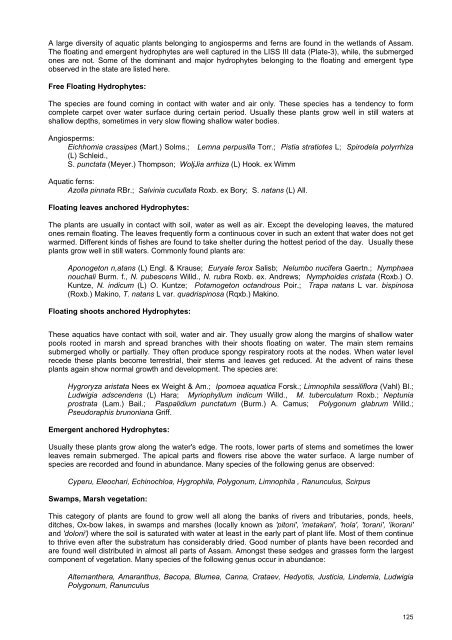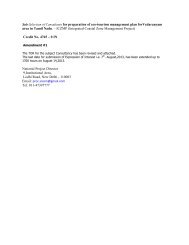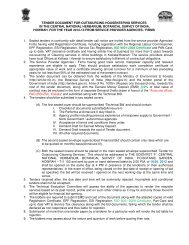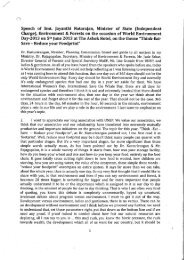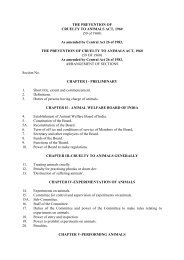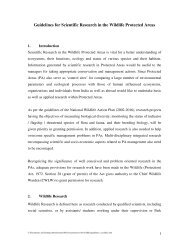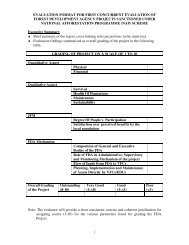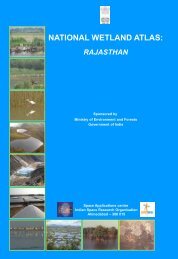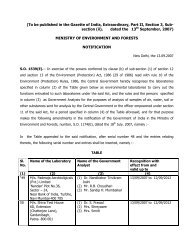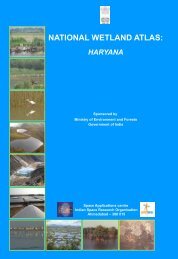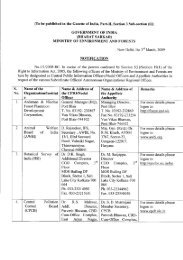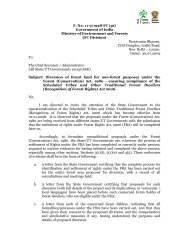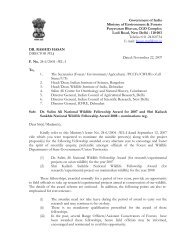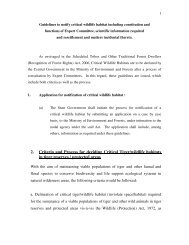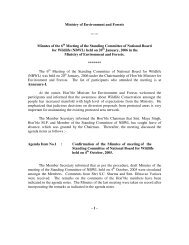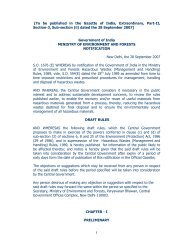Assam - Ministry of Environment and Forests
Assam - Ministry of Environment and Forests
Assam - Ministry of Environment and Forests
You also want an ePaper? Increase the reach of your titles
YUMPU automatically turns print PDFs into web optimized ePapers that Google loves.
A large diversity <strong>of</strong> aquatic plants belonging to angiosperms <strong>and</strong> ferns are found in the wetl<strong>and</strong>s <strong>of</strong> <strong>Assam</strong>.The floating <strong>and</strong> emergent hydrophytes are well captured in the LISS III data (Plate-3), while, the submergedones are not. Some <strong>of</strong> the dominant <strong>and</strong> major hydrophytes belonging to the floating <strong>and</strong> emergent typeobserved in the state are listed here.Free Floating Hydrophytes:The species are found coming in contact with water <strong>and</strong> air only. These species has a tendency to formcomplete carpet over water surface during certain period. Usually these plants grow well in still waters atshallow depths, sometimes in very slow flowing shallow water bodies.Angiosperms:Eichhomia crassipes (Mart.) Solms.; Lemna perpusilla Torr.; Pistia stratiotes L; Spirodela polyrrhiza(L) Schleid.,S. punctata (Meyer.) Thompson; WoljJia arrhiza (L) Hook. ex WimmAquatic ferns:Azolla pinnata RBr.; Salvinia cucullata Roxb. ex Bory; S. natans (L) All.Floating leaves anchored Hydrophytes:The plants are usually in contact with soil, water as well as air. Except the developing leaves, the maturedones remain floating. The leaves frequently form a continuous cover in such an extent that water does not getwarmed. Different kinds <strong>of</strong> fishes are found to take shelter during the hottest period <strong>of</strong> the day. Usually theseplants grow well in still waters. Commonly found plants are:Aponogeton n,atans (L) Engl. & Krause; Euryale ferox Salisb; Nelumbo nucifera Gaertn.; Nymphaeanouchali Burm. f., N. pubescens Willd., N. rubra Roxb. ex. Andrews; Nymphoides cristata (Roxb.) O.Kuntze, N. indicum (L) O. Kuntze; Potamogeton oct<strong>and</strong>rous Poir.; Trapa natans L var. bispinosa(Roxb.) Makino, T. natans L var. quadrispinosa (Rqxb.) Makino.Floating shoots anchored Hydrophytes:These aquatics have contact with soil, water <strong>and</strong> air. They usually grow along the margins <strong>of</strong> shallow waterpools rooted in marsh <strong>and</strong> spread branches with their shoots floating on water. The main stem remainssubmerged wholly or partially. They <strong>of</strong>ten produce spongy respiratory roots at the nodes. When water levelrecede these plants become terrestrial, their stems <strong>and</strong> leaves get reduced. At the advent <strong>of</strong> rains theseplants again show normal growth <strong>and</strong> development. The species are:Hygroryza aristata Nees ex Weight & Am.; Ipomoea aquatica Forsk.; Limnophila sessiliflora (Vahl) Bl.;Ludwigia adscendens (L) Hara; Myriophyllum indicum Willd., M. tuberculatum Roxb.; Neptuniaprostrata (Lam.) Bail.; Paspalidium punctatum (Burm.) A. Camus; Polygonum glabrum Willd.;Pseudoraphis brunoniana Griff.Emergent anchored Hydrophytes:Usually these plants grow along the water's edge. The roots, lower parts <strong>of</strong> stems <strong>and</strong> sometimes the lowerleaves remain submerged. The apical parts <strong>and</strong> flowers rise above the water surface. A large number <strong>of</strong>species are recorded <strong>and</strong> found in abundance. Many species <strong>of</strong> the following genus are observed:Cyperu, Eleochari, Echinochloa, Hygrophila, Polygonum, Limnophila , Ranunculus, ScirpusSwamps, Marsh vegetation:This category <strong>of</strong> plants are found to grow well all along the banks <strong>of</strong> rivers <strong>and</strong> tributaries, ponds, heels,ditches, Ox-bow lakes, in swamps <strong>and</strong> marshes (locally known as 'pitoni', 'metakani', 'hola', 'torani', 'ikorani'<strong>and</strong> 'doloni') where the soil is saturated with water at least in the early part <strong>of</strong> plant life. Most <strong>of</strong> them continueto thrive even after the substratum has considerably dried. Good number <strong>of</strong> plants have been recorded <strong>and</strong>are found well distributed in almost all parts <strong>of</strong> <strong>Assam</strong>. Amongst these sedges <strong>and</strong> grasses form the largestcomponent <strong>of</strong> vegetation. Many species <strong>of</strong> the following genus occur in abundance:Alternanthera, Amaranthus, Bacopa, Blumea, Canna, Crataev, Hedyotis, Justicia, Lindemia, LudwigiaPolygonum, Ranunculus125


